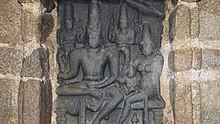Somaskanda

Somaskanda ( Sanskrit : सोमास्कन्द Somāskanda = "Shiva with Uma and Skanda") is a manifestation of the Hindu god Shiva . Shiva is represented as Somaskanda accompanied by his wife Parvati / Uma and his son Skanda . The Somaskanda image type is characteristic of South Indian Hindu art . In terms of content and iconography, it largely corresponds to the Uma-Maheshwara type that is widespread in northern India and Nepal .
iconography
Since the 7th century this type of image has shown the god Shiva, his wife Parvati and their little son Skanda as a family sitting harmoniously and peacefully together on a kind of throne; Shiva is shown with four arms, with at least two of his hands holding attributes (in South India mostly ax (kuthara) and gazelle (minga) ). Uma / Parvati and Skanda each have only two arms, but - like Shiva - wear a crown. In the early depictions of the Pallava period, the gods Brahma and Vishnu usually appear in the background , which are missing in the later Chola bronzes .
distribution
Somaskanda depictions were originally limited to the area in southern India ruled by the Pallava and subsequent Chola dynasties; they are now also available as art prints all over India.
Adoration
There are very few temples dedicated to Somaskanda in southern India. Images of Somaskanda are often found in the side shrines of Skanda ( Tamil Murugan ) and Shiva temples in southern India ; Somaskanda reliefs can also be found inside the cella ( garbhagriha ) of many of these temples. The worship of Somaskanda is generally more of a private or family nature.
In Fideris (Switzerland) there is a Somaskanda Ashram, which has had a temple named accordingly since 2016.
Web links
Individual evidence
- ^ Uma-Maheshvara, Nepal
- ↑ Anneliese and Peter Keilhauer: The visual language of Hinduism. The Indian world of gods and their symbolism. DuMont, Cologne 1986, p. 113, ISBN 3-7701-1347-0
- ^ Somaskanda Ashram, Switzerland
